Jan 2, 2024
16 Brands Doing Corporate Social Responsibility Successfully
Corporate Social Responsibility (CSR) allows businesses large and small to enact positive change. It’s when companies choose to do what’s right not only for their bottom line but also to build customer trust.
Consumers feel that when they use a product or service of a socially responsible company, they are doing their part. The more socially responsible the company, the more supportive its community and consumers become.
Corporate social responsibility helps gain customer trust, raise awareness, and encourage social change. Although many companies do their part, the efforts of large global corporations have far-reaching results that can impact global issues, from hunger and health to global warming and climate change.
Plus with artificial intelligence (AI) being adopted rapidly by companies, businesses now need to link their CSR efforts with their responsible AI efforts (more on that later).
Keep reading to see examples of how some major brands are doing CSR successfully (along with one brand that re-evaluated its CSR strategy after facing criticism for having the wrong kind of social impact).
12 Ways Digital Marketers Can Use ChatGPT
Examples of Corporate Social Responsibility in Action
Corporate social responsibility comes in many forms. Even the smallest company can impact social change by making a simple donation to a local food bank. Some of the most common examples of CSR include:
- Reducing carbon footprints
- Improving labor policies
- Participating in fairtrade
- Diversity, equity and inclusion
- Charitable global giving
- Community and virtual volunteering
- Corporate policies that benefit the environment
- Socially and environmentally conscious investments
Millennials Want to See More Corporate Social Responsibility
To millennials and Generation Z, socially responsible companies are even more important. They believe companies should invest in improving society and look for solutions that assist in those improvements.
A recent poll found that young Americans feel brands need to be held to a higher standard — 80 percent are likely to base their purchases on a brand’s mission or purpose. While 74 percent would boycott brands for crossing an ethical line and going against their personal values.
So, companies need to share how they are trying to make a positive impact on the world, so the public can see their pro-social initiatives. Showcasing efforts is key so it’s important to learn how to market to millennials because these efforts will sway the choices they make as consumers.
Millennials also like to take part in initiatives such as volunteer work or making donations. As ever more companies begin to see the impact their socially and environmentally conscious efforts have on a consumer’s perception, the more chance there is that they will begin initiatives of their own.
Changing Corporate Social Responsibility Trends
Activism by millennials and, indeed, all generations will also influence changing trends in CSR. You can expect to see companies continue to take a public stand against on-the-job harassment and discrimination thanks to the #metoo movement.
Diversity in the workplace will also continue to expand to embrace people of all races, genders, cultures, disabilities, and sexual orientations. Many brands are becoming more vocal and showing their support for important social issues on social media to great effect.
Companies will also find their own voices to speak out against social injustice and policy changes that will negatively impact the environment. Even policies to protect data privacy in an ever-changing environment can become part of the CSR trends as more and more data breaches threaten personal information.
In 2022, Patagonia’s founder, Yvon Chouinard set a new standard in environmental corporate leadership by giving away the company and its future profits to fight climate change.
“If we have any hope of a thriving planet – much less a thriving business – 50 years from now, it is going to take all of us doing what we can with the resources we have,” said Chouinard. “This is another way we’ve found to do our part.”
Corporate Social Responsibility and AI
While AI offers many benefits to organizations - automation, optimization and personalization - it also carries risks.
As AI depends so much on data to learn and provide insights, bad or incorrect data can create skewed results and result in bias that leads to inequality or prejudice. For example, there is a close connection between responsible AI and efforts to promote social and environmental sustainability.
Customers can also be confused about how AI is used in a company and create an environment of mistrust if efforts aren’t made to be transparent and fair in its use.
This is where Responsible Artificial Intelligence or RAI comes in. According to an MIT expert survey, 90% of managers in companies with at least $100 million in annual revenues — reported that their organization’s RAI and CSR efforts are linked.

“From an organizational perspective, the practical implementation of the responsible AI initiative needs to be closely aligned to corporate social responsibility efforts to steer responsible business outcomes,” says Aisha Naseer, Director of research at Huawei Technologies Co. (UK).
In this era of AI, it’s worth determining if you need to revisit your CSR initiatives by looking at the organizational culture, the level of AI maturity in-house and the strengths of CSR efforts (and whether linking them to AI would bolster them).
Brands Doing it Right
1. Renewable Innovation: Johnson & Johnson
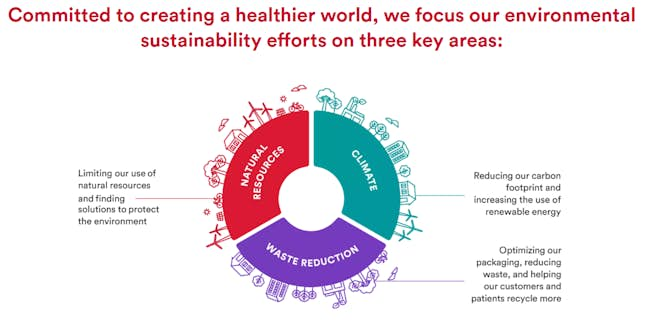
An excellent example of CSR on the frontline is big pharma pioneer Johnson & Johnson. They have focused on reducing their impact on the planet for three decades. Their initiatives range from leveraging the power of the wind to providing safe water to communities around the world.
Their purchase of a privately-owned energy supplier in the Texas Panhandle allowed the company to reduce pollution while providing a renewable, economical alternative to electricity. The company continues to seek out renewable energy options with the goal of having 100% of its energy needs from renewable sources by 2025.
2. Social issues: Google
Google is trusted not only for its environmentally friendly initiatives but also due to its outspoken CEO, Sundar Pichai. He stands up against social issues including President Donald Trump’s anti-Muslim comments and the impact of AI in society in terms of misinformation and fake news.
Google also funds initiatives to drive inclusion both in the company and society in the areas of:
- Racial equity
- Disability inclusion
- Gender equality
- LGBTQ+ inclusion
- Veteran inclusion
The company also builds tools to help minority-owned businesses and communities and factors in accessibility.
3. Sustainability: Coca-Cola
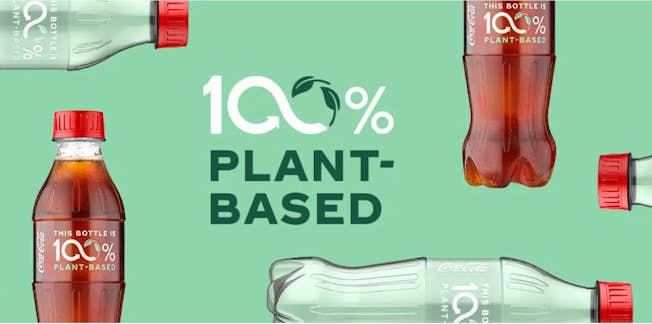
As a brand, Coca-Cola is putting a huge focus on sustainability. The key areas are climate, packaging and agriculture along with water stewardship and product quality.
Their message is ‘a world without waste’, with the aim of collecting and recycling every bottle, making their packaging 100% recyclable and replacing all water used in creating their drinks back to the environment to ensure water security. They aim that by 2030, they will have reduced their carbon footprint by 25%.
A number of years ago Coca-Cola unveiled its first bottle made from 100% plant-based plastic. “Our goal is to develop sustainable solutions for the entire industry. We want other companies to join us and move forward, collectively. We don’t see renewable or recycled content as areas where we want competitive advantage,” said Dana Breed, Global R&D Director, Packaging and Sustainability, The Coca-Cola Company.
4. Carbon neutral & pay equity: Ford Motor Company
Ford has huge plans in the area of CSR. Their mission is to ‘build a better world, where everyone is free to move and pursue their dreams’. They have increased investment in electrification to $22Bn (from an original $11Bn) and aim for their vehicles to be carbon neutral by 2050.
“We’re committed to carbon neutrality”, stated Bob Holycross, Ford’s VP, Chief Sustainability, Environment & Safety Officer. “It’s the right thing for our customers, the planet and Ford. Ninety-five percent of our carbon emissions today come from our vehicles, operations and suppliers, and we’re tackling all three areas with urgency and optimism,”
Interestingly, the company is also focusing on pay equity. They are conducting a diversity, equity and inclusion audit while introducing a global salaried pay ratio (including gender) to level the playing field for all employees.
5 & 6. Employee rights: Netflix & Spotify
From a social perspective, companies such as Netflix and Spotify offer benefits to support their employees and families.
Netflix offers 52 weeks of paid parental leave to the birth parent and non-birth parent (which includes adopted children). This can be taken at any time whether it is the first year of the child's life or another time that suits their needs. This compares to a median of 18 weeks at other major tech companies.
Spotify offers a similar program, although for a shorter duration of 24 weeks of paid leave but employees can take parental leave until their child is three years of age. The program also allows employees one month of flexible work when they return to help transition from being a full-time parent to a full-time employee.
When it comes to social causes, Netflix and Spotify use their social media platforms to show support for movements such as Pride Month, environmental sustainability, and Black Lives Matter. Netflix sets an example of how to target - and appeal to - niche and minority audiences through clever social media. Its channel ‘Strong Black Lead’ is just one example.
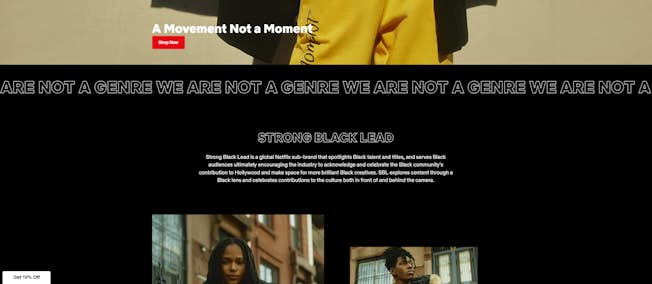
7. Access to healthcare: Pfizer
The Pfizer Foundation was established in 1953 and its goal is to “help build healthier communities around the world”. To do this it supports community-based innovations and safety net healthcare providers, promotes health equity and enables equitable access to vaccines.
They also provide grants in the instance of natural disasters such as Haiti in the aftermath of Hurricane Matthew and the global refugee crisis in Europe and the Middle East. This money is provided in cooperation with NGOs to reach as many people as possible.
Through Pfizer’s Global Health Innovation Grants program, $100,000 is provided each year to twenty organizations to drive solutions to address vaccine-preventable illnesses in their communities. The North Star Alliance in Uganda is one grant recipient.
8. Philanthropic Donations: Wells Fargo
Wells Fargo donates up to 1.5% of its revenue to charitable causes each year to more than 14,500 nonprofits through philanthropy such as food banks and incubators (plant science and renewable energy) to hasten the speed to market for start-ups.
A recent ‘Housing Affordability Breakthrough Challenge’ was established by Wells Fargo to address the housing affordability crisis in America. Winners of the challenge received between $2 to $3 million along with support from peers and industry experts to scale new strategies to make homes more accessible and affordable.
The company also collaborated with Team Rubicon to train veterans to rebuild homes. A $750,000 grant will help to give veterans trade skills such as contracting, electric, and plumbing to use in their communities.
9. Grassroots campaigns: TOMS
TOMS's mission was to donate a pair of shoes for every pair they sell and this has resulted in the donation of over 95 million pairs of shoes to children in need. However, the company faced criticism for creating a dependency on free shoes and collapsing local shoe-making industries.
As a result, TOMS re-evaluated its strategy. Instead of focusing on free shoes, the company now donates one-third of its profits to grassroots campaigns in the areas of mental health, access to opportunity, and ending gun violence.
“We learned that giving shoes, sight, and safe water for over a decade was an amazing start— the right start — to creating meaningful change. But, the decision to give impact grants instead will enable our community to do even more. Rather than giving shoes, we’re giving 1⁄3 of our profits. In other words, $1 for every $3 we make, which is about as much as a company can give while still keeping the lights on.” - TOMS Impact Report.
As a result of their CSR initiatives, TOMS has helped 105 million people’s lives and counting!
10. Climate neutral: Bosch
Bosch set itself ambitious goals for protecting the environment, with an aim to reduce their ecological footprint through climate action, water usage, and a circular economy.
It seems this ambition has paid off and paved the way for other global companies, as 400 of its locations are now climate neutral. The company now wants to reduce upstream (purchased goods and services) and downstream (product use) emissions by 15% in 2030.
“Having achieved our initial targets for scopes 1 and 2, we are now tackling scope 3 emissions with the same degree of rigor – setting specific targets and milestones for the coming years.” - Torsten Kallweit, Head of EHS AND Sustainability
11. Clean technology: GE
It's been over a decade since General Electric launched Ecomagination, its renewable business strategy with a mission to double down on clean technology and generate $20 billion in revenue from green products.
As part of its ‘Ecomagination Challenge’ launched last year, GE awarded five people $100,000 each to develop their innovations such as an inflatable wind turbine, an intelligent water meter, a cyber secure network infrastructure, and short-circuiting and outage technology.
12. Workplace diversity & inclusion: Starbucks
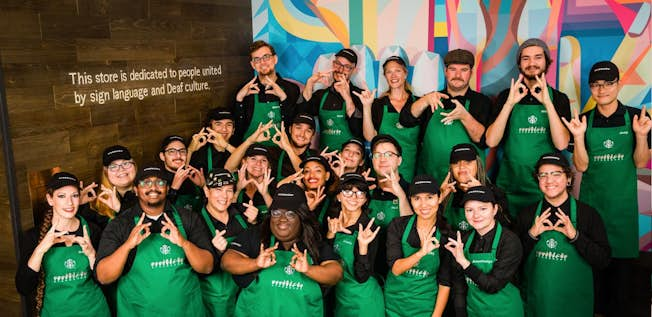
With an eye to hiring, Starbucks wanted to diversify its workforce and provide opportunities for specific cohorts. It has pledged to hire 25,000 US military veterans and spouses by 2025 as part of its socially responsible efforts. The company has surpassed targets, hiring 40,000 veterans and spouses since the launch.
To tackle racial and social equity, Starbucks announced a mentorship program to connect black, indigenous, and people of color (BIPOC) to senior leaders and invest in partnerships. The chain also aims to have BIPOC represented at 30% in corporate roles and 40% in retail and manufacturing by 2025.
Read: ‘Digital Accessibility: What Marketers Need to Know’ to find out how you can make your marketing activities more accessible.
13. Sustainability: New Belgium Brewing Company
This brewing company owned entirely by its employees through a stock ownership plan is focused on sustainability. Its Fort Collins, Colorado brewery produces its electricity through solar panels and wastewater and aims to have all its beer carbon neutral by 2030.
New Belgium Brewing Company prides itself on reaching some key milestones. It is the first wind-powered brewery in the United States, the first certified carbon-neutral beer in North America (Fat Tire), and the first to achieve a perfect score of 100 on the Human Rights Campaign’s Corporate Equality Index.
It also gives away $1 of every barrel sold to support its philanthropic initiatives, values and goals giving away $30 million so far. According to the Director of CSR, Katie Wallace: “We consider social and environmental well-being to be intricately intertwined.”
14. Local communities: The Walt Disney Company
Disney committed to reducing emissions and waste along with using sustainable design and sustainable materials in its 2030 Environmental Goals report. Some of the goals include achieving net zero emissions for direct operations, using plastic that contains at least 30 percent recycled content or a lower-impact alternative material and eliminating single use plastics on cruise ships by 2025.
They are actively ensuring strict international labor policies to protect the safety and rights of their employees.
They are also active in the community and encourage employees to do the same. Through Disney’s VoluntEARS program, employees and cast members worldwide have volunteered 13 million hours of service to their communities while more than $140 million of Disney’s donations were directed to programs serving underrepresented communities.
15. Packaging: LEGO
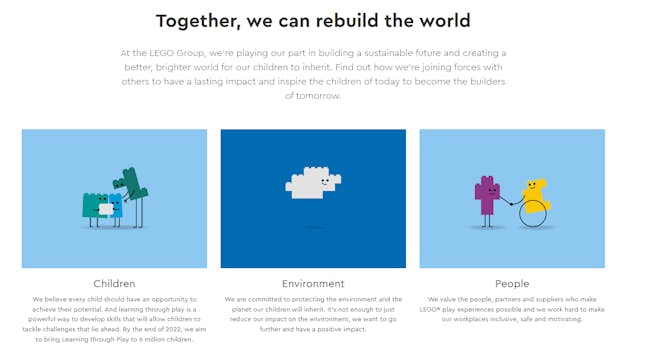
Lego has tripled spending on sustainability initiatives to $1.4 billion by 2025 with a focus on making products from more sustainable and circular materials by 2032.
Their primary focus as a modern-day superbrand is to phase out single-use plastic packaging for its bricks with all packaging to be sustainable by 2025. While testing on creating a sustainable brick has been challenging, the company is committed to continuing its research to come up with a viable solution.
Currently, 93% of packaging is made from paper, cardboard, and other paper-based materials. Work is now underway to replace single-use plastic pre-pack bags in LEGO boxes with paper-based ones in partnership with the Forest Stewardship Council.
LEGO Group CEO, Niels B Christiansen said: “We cannot lose sight of the fundamental challenges facing future generations. It’s critical we take urgent action now to care for the planet and future generations. As a company that looks to children as our role models, we are inspired by the millions of kids who have called for more urgent action on climate change.”
16. . Social media & journalism: The Washington Post
In the wake of fake news, news outlets are taking to social media networks like TikTok and Threads to address a new audience and tackle false information around issues such as the U.S. election and coronavirus.
The Washington Post is one example of a news brand using TikTok successfully. Their tagline is ‘We are a Newspaper’ and their TikTok profile already has 1.7 million followers (and growing). Their goal? To draw in new readers and build trust using short-form videos and viral content.
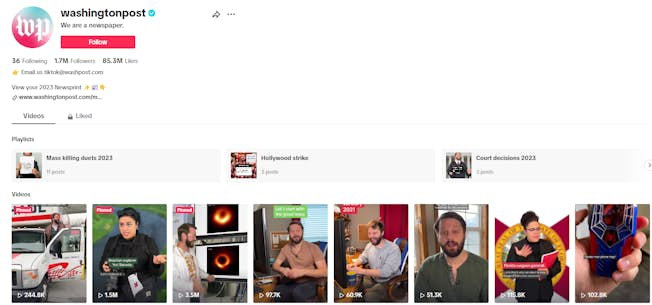
According to Dave Jorgensen, the Post’s social media guru, the rapid rise of TikTok is down to the fact that the platform has increased the trust between the paper and its followers. He believes that TikTok is journalism in every sense. “Pretty much every other TikTok has something news related in it and with that we are delivering news to the users. That’s what journalism is – delivering news however you are able to in a responsible way.”
Use digital marketing channels to engage and convert
For brands of all sizes, it's key to pay attention to the issues your customers are interested in. Advance your marketing knowledge and career with DMI’s industry-aligned and certified Professional Diploma in Digital Marketing. The course explores digital marketing fundamentals, social media marketing, SEO, analytics, AI, PPC, email marketing, and much more. Get started today!
Updated 2024
Related
- Categories:
- Articles
- Digital Strategy
- Digital Marketing
Upgrade to Power Membership to continue
your access to thousands of articles, toolkits, podcasts, lessons and much much more.
Become a Power Member- Login
- View Courses
- - - -
- Courses
- Resources
- - - -
- My Account
- Change Password
- Logout




